32 Latest Chatbot Statistics For 2024: Usage, Demographics, Trends

In need of a few chatbot statistics?
Chatbots are changing the way we use the internet and interact with customer service, especially chatbots that utilize artificial intelligence (AI).
In this post, we list the best statistics from reports around the web and include data on chatbot usage, market size, consumer opinions and more.
Editor’s top picks – chatbot statistics
These are the best chatbot stats from this post:
- The global market size for the chatbot industry will reach $27.3 billion by 2030. (Grand View Research)
- 30% of C-level support executives will make automated chatbot support a main priority of 2024. (Intercom)
- 87.2% of consumers have had positive or neutral interactions with chatbots. (Startup Bonsai)
- 62% of consumers prefer using chatbots over waiting to speak with human agents. (Tidio)
- 19% of online businesses are already making use of chatbots. (Tidio)
- 35% of consumers who used chatbots in 2023 did so in place of search engines or to have something explained. (Consumer Reports)
General chatbot statistics
1. The global chatbot market size will reach $27.3 billion by 2030
This figure comes from a study conducted by Grand View Research on the global chatbot industry.
The global chatbot market size was valued at $5.1 billion in 2022 and $6.3 billion in 2023.
The market will grow at a compound annual growth rate (CAGR) of 23.3% between now and 2030.

This puts its estimated market size at $27,297.2 million in 2030, or $27.3 billion.
Source: Grand View Research
2. 20% of page visitors interact with upselling chatbots
In Tidio’s survey on chatbots, the company included data from its own chatbots that detail the percentage of page visitors who interacted with different types of chatbots.
According to their data, 20% of page visitors interact with upselling chatbots, the most of any chatbot type.
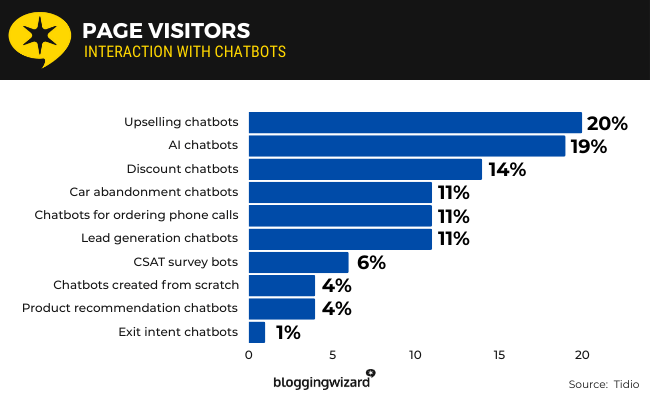
Here’s the full list of results from Tidio:
- Upselling chatbots – 20% of page visitors have this type of chatbot conversation
- AI chatbots – 19%
- Discount chatbots – 14%
- Cart abandonment bots – 11%
- Chatbots for ordering phone calls – 11%
- Lead generation chatbots – 11%
- CSAT survey bots – 6%
- Chatbots created from scratch by users – 4%
- Product recommendation chatbots – 4%
- Exit-intent chatbots – 1%
Source: Tidio
3. LiveChat customers have earned an average satisfaction rating of 63.6% for their use of chatbots
In 2022, LiveChat customers conducted 104,765,026 chats with customers.
26,384,031, or 25.18%, of those chats included chatbots.
LiveChat customers who used LiveChat’s chatbot functionality experienced an average customer satisfaction rating of 63.6% from live chat sessions that included chatbots.
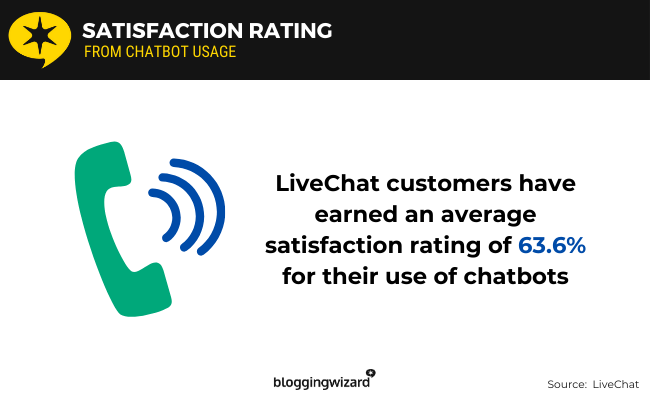
Source: LiveChat
4. 30% of C-level support executives name implementing automated support with chatbots a main priority of 2024
According to Intercom’s Customer Service Trends report for 2024, 30% of C-level support executives say implementing automated support with chatbots is a main priority of 2024.
Here are other priorities of C-level support executives for 2024:
- Increasing workflow efficiency – 47% of C-level support executives name this a main priority for 2024
- Empowering customers to self-serve answers to their own questions – 40%
- Helping the organization retain or grow its customer base – 34%
- Automated support with chatbots – 30%
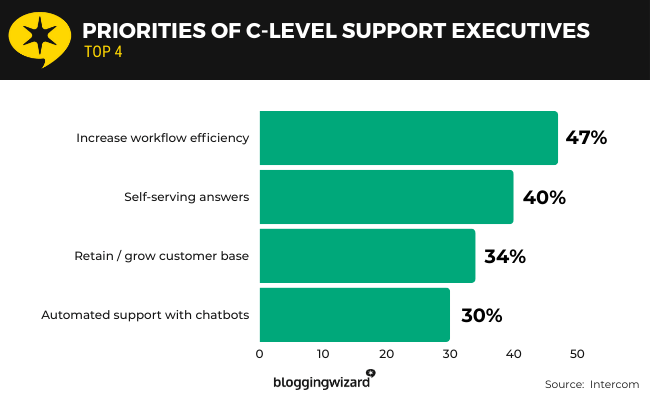
Source: Intercom
5. 42% of support leaders believe a “chatbot analyst” position will be added to support teams in the coming years
With AI and chatbots entering support departments, Intercom thought it was a good idea to ask support executives about new positions that may become crucial to support teams in the future.
“Chatbot analyst” was among the positions executives were asked about. 42% believe this position will be added to support teams in the future.
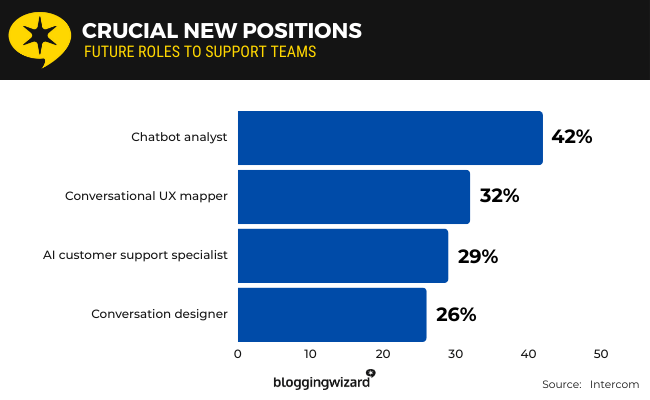
32% say “conversational UX mapper” will become relevant while 29% say “AI customer support specialist.”
26% believe “conversation designer” will become a new position in the future as well.
Source: Intercom
Consumer-based chatbot statistics
6. 87.2% of consumers have had neutral or positive experiences with chatbots
According to a survey conducted by Drift and published by Startup Bonsai, the majority of consumers, or 87.2%, have had neutral or positive experiences with chatbots.
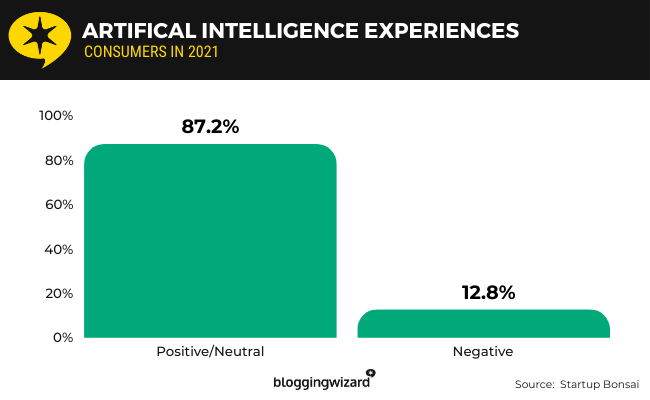
Only 12.8% have had negative experiences with this type of technology.
Source: Startup Bonsai
7. 62% of consumers would rather use a chatbot than wait for a human customer service agent
According to a survey conducted by Tidio, which included responses from over 700 online business owners and over 700 consumers, 62% of consumers would rather use a chatbot than wait to speak with a customer service agent.
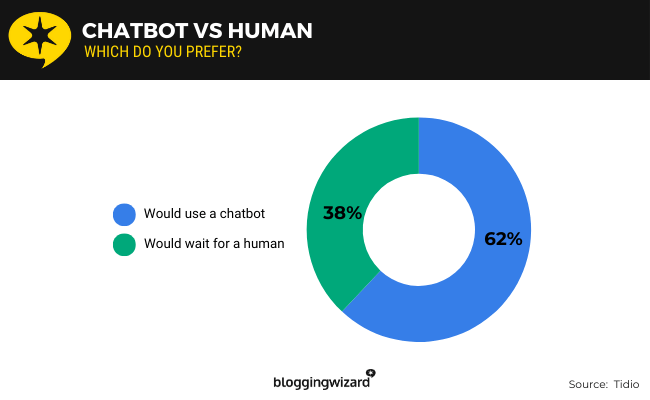
Tidio also asked consumers which type of support they’d prefer in specific situations: bot or human.
71% of consumers would prefer to chat with a chatbot when checking the status of an order.
72% would prefer to speak with a human agent to complain about a product or service.

Here are the full results from this part of the survey:
- Checking order status
- Chatbot – 71% of consumers would prefer to chat with a bot for this purpose
- Human – 29% of consumers would prefer to speak with a human for this purpose
- Searching for products
- Chatbot – 67%
- Human – 33%
- Getting information about deals and discounts
- Chatbot – 62%
- Human – 38%
- Ordering food
- Chatbot – 59%
- Human – 41%
- Booking a meeting (via Zoom or another platform)
- Chatbot – 58%
- Human – 42%
- Leaving contact details
- Chatbot – 58%
- Human – 42%
- Making a payment
- Chatbot – 54%
- Human – 46%
- Returning a product
- Chatbot – 46%
- Human – 54%
- Troubleshooting
- Chatbot – 40%
- Human – 60%
- Complaining about a service or a product
- Chatbot – 28%
- Human – 72%
Source: Tidio
8. 96% of consumers have heard of chatbots
Tidio’s survey revealed that a huge majority of consumers, or 96%, know what chatbots are.
Source: Tidio
9. 88% of consumers chatted with at least one chatbot in 2023
Tidio’s survey also revealed that the majority of consumers, or 88%, chatted with at least one chatbot in 2023.
Source: Tidio
10. 29% of consumers mostly expect chatbots to be available 24/7
Tidio’s survey revealed details on what customers expect from chatbots.
The data revealed that they mostly expect chatbots to be available at all times. In fact, 29% of consumers felt this way.
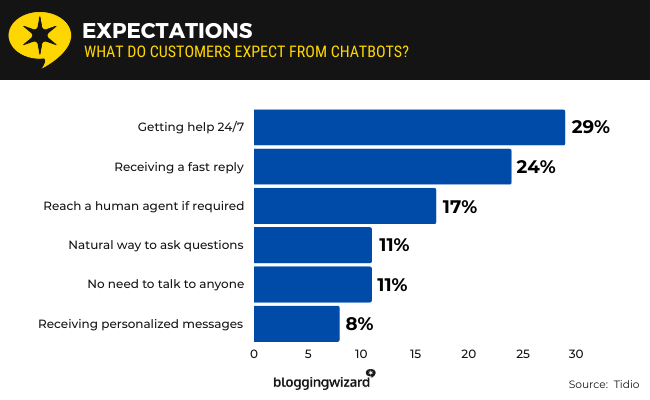
Here’s what else consumers expect from chatbots:
- Getting help 24/7 – 29% of consumers expect this from chatbots
- Receiving a fast reply – 24%
- Being able to reach a human agent if I want to – 17%
- Using messages for asking questions in a natural way instead of using search bar – 11%
- No need to talk to anyone – 11%
- Receiving personalized messages – 8%
Source: Tidio
11. 38.12% of customers find it annoying when a live chat’s chatbot is unable to understand context
Hiver surveyed over 1,200 consumers from around the United States on how they use and view customer support.
According to the survey, the majority of customers, or 38.12%, find the chatbot’s inability to understand context the most annoying aspect of live chat.
That’s a huge amount. And it will affect things like customer retention.
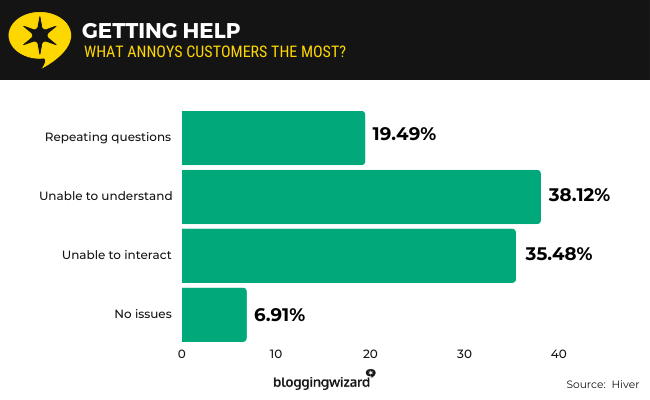
These are the full results from this survey:
- Chatbot unable to understand context – 38.12% of customers find this aspect of live chat to be most annoying
- Unable to interact with an actual human – 35.48%
- Having to repeat the question multiple times – 19.49%
- No issues with customer support – 6.91%
Source: Hiver
12. 5% of Gen Z consumers around the world use chatbots to research products
According to a survey of over 8,900 consumers in the Generation Z age demographic, 5% of Gen Z consumers use chatbots to research products.
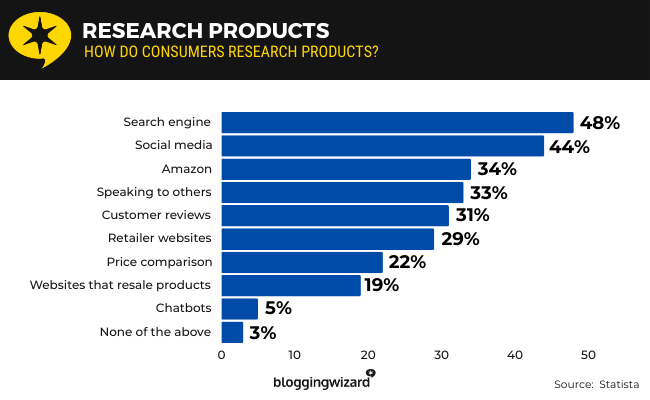
These are the full survey results, demonstrating how chatbots compare to other sources:
- Search engines – 48% of Gen Z consumers use this source to research products
- Social media – 44%
- Amazon – 34%
- Speaking to friends, family and colleagues – 33%
- Customer reviews on other retailer websites – 31%
- Retailer websites – 29%
- Price comparison websites – 22%
- Websites/apps that sell used, recycled and upcycled products – 19%
- Chatbots – 5%
- None of the above – 3%
Source: Statista1
Business-based chatbot statistics
13. 44% of support teams are planning to invest in chatbots in 2024
Intercom’s survey revealed that support teams plan to invest in chatbots the most.
According to the survey, 44% of support teams will invest in chatbots in 2024.
42% will invest in customer behavior analysis and 29% will invest in knowledge base enhancement.
Source: Intercom
14. 19% of online businesses are using chatbots
According to Tidio’s survey, 19% of online businesses, such as ecommerce stores, are already using chatbots.

62% plan on adding chatbots to their customer service portal while 19% don’t want to.
It’s also worth noting that online shoppers are becoming more and more familiar with chatbots.
Source: Tidio
15. 74% of online businesses who use chatbots are satisfied with them
Tidio’s survey also revealed that of online businesses who use chatbots, 74% are satisfied with them.

22% have a neutral opinion of chatbots while 4% are not satisfied with them.
Source: Tidio
16. 26% of businesses want to provide faster replies to messages through the use of chatbots
According to Tidio’s survey, which included responses from over 700 online businesses, 26% of businesses use chatbots with the goal of providing faster responses to customer queries in chat.

Here are other goals businesses want to achieve with chatbots:
- Faster replies to messages – 26% of businesses want to achieve this goal with chatbots
- Offer customer support around the clock – 20%
- Automatic replies to repetitive questions – 18%
- Marketing and lead generation – 17%
- Reduce the number of customer service emails – 11%
- Reduce checkout dropoff with discounts – 8%
Source: Tidio
AI chatbot statistics
17. The global AI chatbot market size will reach $72.6 billion by 2028
According to a study of the global AI chatbot market conducted by Industry Expert Research, the global market size for AI chatbots is expected to reach $71,620 million, or $72.6 billion, by 2028.
This is up from $3,335.3 million, or $3.3 billion, in 2021.
The industry will grow at a CAGR of 51% between now and 2028.
Source: Business Growth Reports
18. Of consumers who used an AI chatbot in 2023, 19% used ChatGPT
Consumer Reports surveyed over 2,000 U.S. adults about their use of AI chatbots over a three-month period in mid-2023.
Although 69% of respondents did not use an AI chatbot in 2023, of those who did, 19% used ChatGPT.
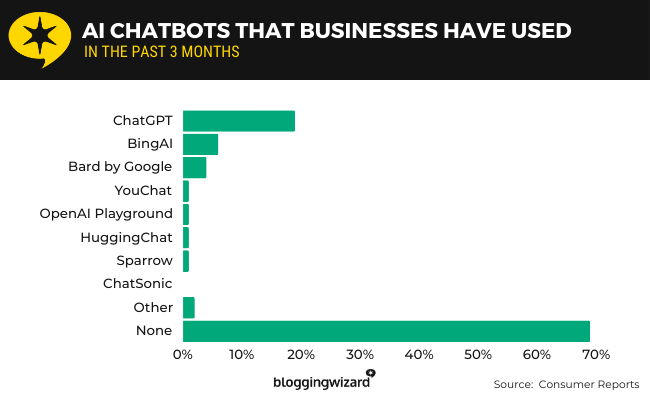
6% used Bing AI, and 4% used YouChat.
OpenAI Playground, HuggingChat, Sparrow by DeepMind and ChatSonic each received 1% of responses.
2% chose “other,” and 4% chose “I have used an AI chatbot in the past three months, but I do not remember what it was.”
Source: Consumer Reports
19. Of consumers who used AI chatbots in 2023, 35% used them in place of search engines or to explain something
Consumer Reports’ survey of over 2,000 U.S. adults revealed that the majority of users used AI chatbot technology in search of knowledge.
35% used AI chatbots to answer a question instead of searching for it with search engines, and another 35% had them explain something.
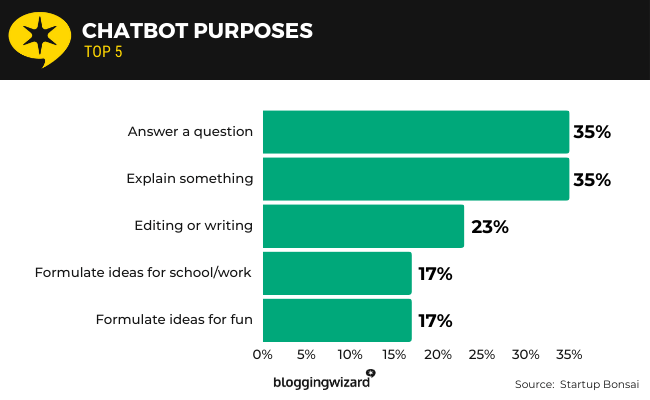
Here are other ways in which consumers used AI chatbots in 2023:
- Answer a question, using the chatbot instead of a search engine – 35% of consumers used AI chatbots for this purpose
- Have it explain something – 35%
- Write, rewrite or edit something to accomplish a task – 23%
- Come up with ideas for an assignment for work or school – 17%
- Come up with ideas not related to work or school – 17%
- Have it summarize a longer piece of text – 14%
- Write, rewrite or edit something for an artistic or entertainment purpose – 14%
- Get product recommendations – 13%
- Have a conversation with someone – 13%
- Translate something from one language to another – 12%
- Generate computer code – 10%
- Come up with travel plans – 9%
- Other – 4%
- I just wanted to see what it was like – 13%
Source: Consumer Reports
20. ASAPP received $380 million in funding in 2023
According to data published by Statista, ASAPP, who operate generative AI software for customer service companies, received the majority of funding for chatbot startups in 2023.
The company received $380 million in funding in 2023.
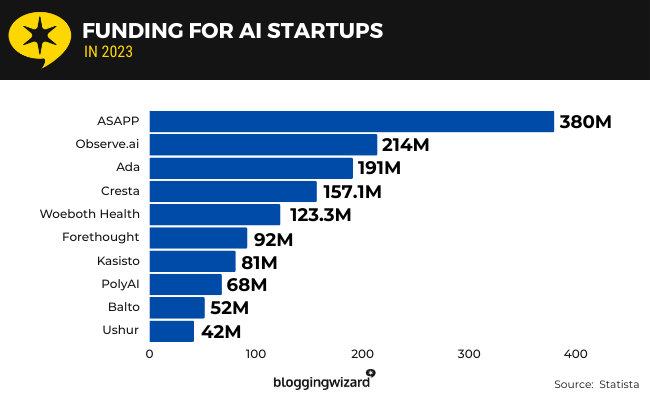
Here’s how much other chatbot and conversational AI startups received in funding in 2023:
- ASAPP – This company received $380 million in funding in 2023
- Observe.ai – $214 million
- Ada – $191 million
- Cresta – $157.1 million
- Woebot Health – $123.3 million
- Forethought – $92 million
- Kasisto – $81 million
- PolyAI – $68 million
- Balto – $52 million
- Ushur – $42 million
Source: Statista2
Related reading: The Top Generative AI Statistics You Should Know.
21. 45% of support teams are already using AI
According to Intercom’s latest Customer Service Trends report, 45% of support teams are already using AI.
Of those who have adopted AI, the majority state that between 11 and 30% of their support requests are being resolved by AI.
Furthermore, 56% of support teams are optimistic about AI’s ability to improve customer service.
Source: Intercom
22. 50% of executives name AI’s ability to provide support 24/7 as a top benefit for using AI chatbots
In Intercom’s report, the company asked executives about the benefits that come with using AI in support.
While options included efficiency and customer support costs, the majority of respondents, or 50%, chose “24/7 support availability.”
Here’s how other options fared:
- 24/7 support availability – 50% of executives find this aspect of AI to be beneficial for support
- Time savings – 45%
- Fast and efficient resolution of customer issues – 44%
- Cost efficiency – 35%
- Customer feedback analysis – 35%
- Increased quality and consistency across support – 35%
Source: Intercom
23. 35% of support teams say AI is helping them save on time spent analyzing customer feedback
Customer feedback is important for businesses and even more important for the success of a business’ support department.
When it comes to AI helping support teams save time, 35% say the technology is helping them save time spent on analyzing customer feedback.
34% say AI is able to suggest answers from knowledge base content while 28% say AI is able to transform notes and bullet points into full answers to customer questions.
25% like that AI is able to summarize a customer support interaction.
Source: Intercom
24. 61% of customers prefer the faster response times AI chatbots offer over the wait times associated with human agents
CEO and founder of Hospitable Pierre-Camille Hamana polled new customers about the company’s use of AI chatbots.
They found that the majority of customers, or 61%, prefer the faster response times of AI over waiting to speak with human customer service agents.
Intercom’s report recommends using AI chatbots to improve speed of response, speed of resolution and availability.
They recommend using human support agents to improve the level of knowledge and expertise your support department offers as well as in situations that require politeness and empathy.
Source: Intercom
25. 70% of C-level support executives will invest in AI in 2024
According to Intercom’s survey, the majority of C-level support executives, or 70%, will invest in AI in 2024.
20% invested a significant amount in AI in 2023.
Source: Intercom
26. Of consumers who have used AI chatbots for health-related purposes, 8% used them to look up medical term definitions
Consumer Reports surveyed U.S. consumers about their use of AI chatbots for health-related purposes.
Of those who used AI chatbots for health-related purposes, 8% used them to look up what medical terms mean.
Here are the rest of the results from this question:
- Look up what a medical term means – 8% of consumers used AI chatbots for this health-related purpose
- Look up nutrition facts – 7%
- Ask health-related questions – 7%
- Look up a symptom to see whether someone is sick – 7%
- Learn about a specific medical condition – 7%
- Develop an exercise routine – 6%
- Develop a meal plan – 4%
- Other health-related topics – 1%
- I have used a chatbot in the past six months, but not for any health-related topics – 16%
- I have not used a chatbot at all in the past six months – 63%
Source: Consumer Reports
27. 45% of consumers believe AI chatbot companies should not store health-related chat information
When Consumer Reports asked consumers about what they think is acceptable for AI chatbot companies to do with the interactions they make with chatbots for health-related purposes, 45%, which was the majority, say companies should never store this type of information.
Here’s how other options fared:
- The companies should never store the information – 45% of consumers think this is an acceptable way for AI chatbot companies to handle customer interactions for health-related topics
- Store the information as part of a person’s user profile, but not share it with any other companies – 33%
- Use the information to train a program, such as affecting how a chatbot would respond to other people – 29%
- Store the information and use it to make changes to the service – 26%
- Share or sell the information to organizations that would not use it in any way that affects the person using the chatbot – 12%
- Share or sell the information to organizations that would use it in a way that affects the person using the chatbot – 5%
Source: Consumer Reports
Live chat statistics
28. 63.28% of customers use live chat to contact customer service
According to Hiver’s survey, although the majority of customers prefer to use email to contact a business’ customer service department, a large portion, or 63.28%, also use live chat.
Here are the full results from Hiver’s survey:
- Email – 77.33% of customers use this support option to contact customer service
- Live chat – 63.28%
- Phone – 63.43%
- Social media (including live messaging apps like Facebook Messenger) – 28.65%
- Communities and forums – 10.48%
Source: Hiver
29. Each live chat agent chats with customers for an average of 3 hours and 17 minutes per day
According to LiveChat’s annual report, which includes data from its own LiveChat software, each live chat agent chats for an average of three hours and 17 minutes every day.
This works out to 24.3 chats per agent on average.
Source: LiveChat
30. Live chat sessions last for an average of 8 minutes and 8 seconds
LiveChat’s report states that the average live chat session lasts for eight minutes and eight seconds.
First response time is 40 seconds on average per chat.
Businesses are available to chat for an average of 11 hours and 59 minutes every day, and businesses spend an average of 10 hours and 23 minutes chatting with customers every day.
Source: LiveChat
31. Average queue times are 4 minutes and 9 seconds
When the system has to place customers into queues due to an influx of chat requests, average queue times are four minutes and nine seconds.
Source: LiveChat
32. 73.9% of live chat sessions occur on mobile devices
According to LiveChat’s data, the vast majority of live chats, or 73.9%, occur on mobile devices.
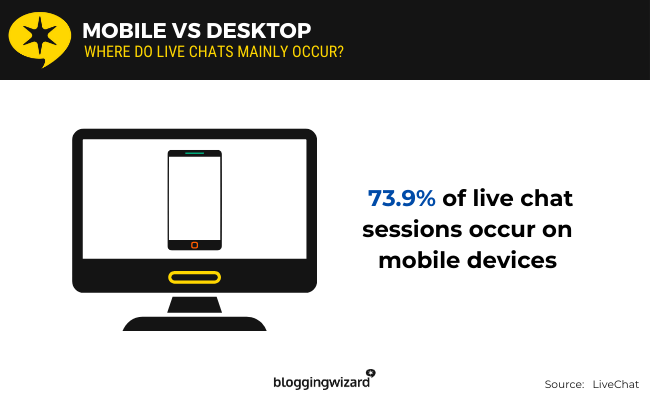
26.1% occur on desktop.
Source: LiveChat
Sources
- Business Growth Reports
- Tidio
- LiveChat
- Intercom
- Startup Bonsai
- Hiver
- Statista1
- Industry Expert Research
- Consumer Reports
- Statista2
Final thoughts
That concludes our list of chatbot statistics and AI chatbot statistics.
We learned how valuable chatbots are becoming for customer communication, especially the ability of AI chatbots to be available to respond to customer queries 24/7.
We also learned how important chatbots are becoming as another source of information instead of relying on search engines for all queries.
If you’re interested in implementing a chatbot on your site, check out our post on the best chatbot software applications.
